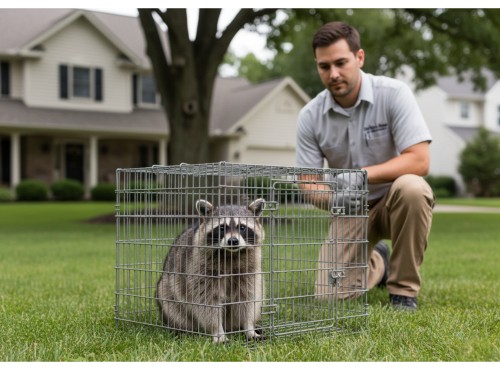Pest control for raccoons is a service that blends wildlife biology, building science, and public health safety. Costs vary depending on the extent of infestation, location of the entry points, and whether exclusion, cleanup, or restoration work is required. Residents across neighbourhoods such as Woodbridge, Maple, and Vellore Village face similar urban wildlife pressures, particularly during winter denning season and spring birthing periods.




| Service Type | Description | Average Price Range (CAD) | Example Vaughan Area |
|---|---|---|---|
| Initial Inspection & Assessment | Full roof-to-foundation inspection, identification of entry points, and thermal imaging for hidden activity. | $150 – $250 | Rutherford & Dufferin corridors |
| One-Way Door Installation | Humane exclusion device allowing raccoons to leave without re-entry; includes follow-up check. | $300 – $600 | Kleinburg and Islington Avenue homes |
| Complete Exclusion & Roofline Sealing | Installation of galvanized steel mesh on roof vents, soffits, and chimney caps. | $800 – $1,500 | Woodbridge & Highway 7 corridor |
| Attic Cleanup and Disinfection | Removal of feces, nesting materials, and urine-contaminated insulation. Use of enzymatic disinfectants and HEPA vacuums. | $400 – $900 | Near Vaughan Mills Mall |
| Full-Service Wildlife Removal Package | Multi-step program: inspection → exclusion → cleanup → follow-up monitoring. | $1,200 – $2,000 | Vellore Village & Maple Ridge areas |
Note: Prices vary based on roof pitch, height, accessibility, and the number of active entry points. Homes with multiple raccoon dens or secondary pest activity (such as squirrels or mice) may incur additional costs.
Certified wildlife control technicians in Vaughan follow a multi-phase humane protocol that complies with Ontario’s Fish and Wildlife Conservation Act and municipal bylaws. Below are the core methods used in raccoon removal:
Comprehensive Site Inspection
Every removal begins with an exterior and attic inspection. Technicians identify entry holes, footprints, rub marks, and urine odour zones. Common access points include roof vents, soffit junctions, eaves, and uncapped chimneys.
Humane Exclusion Process
One-Way Door Systems: Installed at active entry points to let raccoons exit safely without returning.
Timing Considerations: During birthing season (March–June), young kits are removed manually to prevent orphaning.
Exclusion Materials: Heavy-gauge galvanized mesh, chimney caps, and metal flashing are used to seal all structural openings.
Sanitization and Odour Control
Once raccoons are evicted, bio-enzymatic cleaners and HEPA vacuum systems are employed to remove feces, parasites, and roundworm spores. This step is essential for both public health protection and odour mitigation.
Structural Repair and Reinforcement
Damaged insulation, fascia boards, or roof sheathing are repaired. Technicians often apply rodent-proof sealant and weather-resistant flashing to prevent re-entry.
Preventive Measures
Secure garbage bins with locking lids to deter night foraging.
Install motion-activated lighting near sheds and garages.
Trim tree branches at least two metres from the roofline.
Maintain regular roof inspections, especially before winter, to prevent sheltering activity.
Building Type: Detached homes and multi-level properties in areas like Sonoma Heights or Concord often require ladder or lift access, adding labour costs.
Infestation Stage: Active birthing nests, secondary pest infestations, or multiple access points significantly affect pricing.
Cleanup Complexity: Heavily contaminated insulation or confined attic spaces increase cleanup duration.
Weather & Season: Emergency winter calls during extreme cold or snow conditions may carry premium rates due to access challenges.
Compliance and Licensing: Companies with structural applicator licenses and WSIB coverage typically reflect higher, but justified, service rates.
When selecting a raccoon removal service in Vaughan:
Verify Ontario trapping and exclusion licensing.
Confirm insurance and WSIB coverage.
Ask for written warranties on exclusion materials (usually 1–3 years).
Ensure humane practices and avoidance of harmful poisons.
Request before-and-after photos for proof of work.
Professional raccoon removal in Vaughan generally costs between $300 and $2,000, depending on the scope of work and property type. Investing in a comprehensive exclusion plan, rather than a short-term trap-and-release, saves homeowners from repeated invasions and costly attic repairs.
By integrating inspection, exclusion, and prevention, property owners can achieve lasting protection while maintaining humane treatment standards consistent with Vaughan’s conservation and municipal guidelines.
Raccoons are highly intelligent, strong, and adaptable creatures. Especially in suburban environments like Vaughan, where ample food sources and shelter make homes inviting targets. While professional wildlife control is often the most reliable solution, homeowners can take several do-it-yourself (DIY) measures to deter raccoon activity, secure their property, and minimize the risk of invasion.
These steps are particularly valuable for residents in neighbourhoods such as Woodbridge, Maple, Concord, and Vellore Village, where mature trees, backyards, and detached homes provide ideal raccoon access routes.
Raccoons are drawn to organic waste and pet food. Improperly sealed garbage bins are the most common attractant in suburban Vaughan.
Practical Steps:
Use heavy-duty bins with locking lids (city-issued or wildlife-resistant models).
Store bins inside garages or sheds until collection day.
Rinse food containers before disposal.
Freeze food scraps overnight before trash day to reduce odour.
Avoid leaving pet food or bird seed outdoors overnight.
The City of Vaughan’s waste management bylaw encourages residents to secure organics bins with bungee cords or snap locks to minimize wildlife interference.
Raccoons exploit roof junctions, loose soffits, vents, and attic openings. Homeowners can perform basic visual checks using binoculars or from a ladder if it’s safe.
DIY Checks:
Look for bent vents, lifted shingles, or dislodged soffit panels.
Inspect chimney flues for missing or broken caps.
Identify any grease or rub marks – a sign of raccoon passage.
Apply temporary repairs using hardware cloth or metal flashing until a professional can inspect.
Safety Note: Avoid entering attics if you suspect active animals. Raccoons can be aggressive when cornered, particularly if kits (babies) are present.
Trees act as natural bridges for raccoons. Branches extending near the roofline create easy access routes to vents or attic gaps.
Preventive Yard Work:
Trim branches to maintain at least 2 metres (6 feet) of clearance from the roof.
Remove climbing aids, such as stacked firewood or trellises, near walls.
Clean up fallen fruit and bird seed regularly.
Secure compost piles with fine mesh or covered bins.
Vaughan’s mature neighbourhoods like Sonoma Heights and Kleinburg have abundant tree cover, making seasonal yard maintenance one of the simplest yet most effective deterrents.
Raccoons are nocturnal and prefer quiet, dark environments. Light and sound deterrents can discourage them from frequenting your property.
Homeowner Options:
Use motion-activated LED floodlights near sheds, garages, and garden areas.
Install ultrasonic repellent devices – models that emit variable high-frequency sound.
Consider radio-based deterrents set on timers for backyard sheds or patios.
While no electronic device provides 100% protection, these can be useful components in a layered prevention strategy.
If raccoons have accessed garbage areas or sheds, prompt cleaning is essential.
Their feces can contain Baylisascaris procyonis, a roundworm parasite dangerous to humans and pets.
DIY Sanitation Steps:
Wear gloves, mask, and disposable coveralls.
Spray affected surfaces with a 10% bleach solution or EPA-approved disinfectant.
Double-bag droppings and contaminated materials for disposal.
Wash hands thoroughly after cleanup.
Avoid vacuuming feces or nesting material because this can aerosolize harmful spores.
While some residents attempt to seal entry points on their own, timing and technique are crucial.
Do not seal openings until you’re certain all raccoons have left. Trapping or blocking access during spring birthing season (March–June) can lead to trapped young inside attics or walls.
If you suspect an active nest:
Wait until late evening, when adults typically leave to forage.
Observe from a safe distance for movement or noise.
Use flour tracking (sprinkle flour at entry points and check for footprints).
Once certain the nest is empty, seal the gap with galvanized mesh and screws.
If any uncertainty remains, contact a licensed wildlife control technician to conduct a humane removal and confirm full exclusion.
DIY prevention reduces the likelihood of invasion, but active infestations, particularly involving attic nests, require professional handling.
Technicians use one-way door systems, exclusion-grade materials, and thermal inspections to ensure raccoons and their offspring are safely removed.
Attempting capture without proper equipment or training can lead to injury, property damage, or legal violations under Ontario’s wildlife regulations.
Homeowners can significantly lower raccoon risks through consistent garbage management, yard upkeep, and attic inspection routines. These measures, combined with professional exclusion work, create a long-term solution for wildlife control that protects both families and local ecosystems.
For ongoing prevention, consider seasonal inspections before winter and spring. These are periods when raccoons are most likely to seek indoor shelter.
This city’s steady urban growth, stretching from Woodbridge and Maple to Vellore Village and Kleinburg, consists of a dynamic blend of residential neighbourhoods, conservation zones, and commercial spaces. This same development, however, creates an ongoing interface between humans and urban wildlife, particularly raccoons. With access to garbage bins, attic voids, and backyard sheds, raccoons have learned to thrive in the city’s suburban environment.
Creating a wildlife-resilient Vaughan requires cooperation among homeowners, property managers, and local authorities. The goal isn’t just to remove raccoons. It’s to maintain a long-term ecological balance that protects public health, property, and local biodiversity.
Raccoons are a permanent part of the York Region ecosystem. Their intelligence and adaptability mean that exclusion, not eradication, is the only sustainable approach. The City of Vaughan and York Region Public Health emphasize education and prevention through community programs, reminding residents to secure food waste and maintain proper waste storage.
Effective prevention depends on:
Community compliance with garbage storage bylaws and compost guidelines.
Public awareness campaigns run through the environmental department.
Collaboration between pest management professionals and homeowners to establish long-term exclusion strategies.
Neighbourhoods near Boyd Conservation Area and the Kortright Centre for Conservation experience higher wildlife pressures, given their proximity to green belts. These areas often benefit most from regular roof inspections and exclusion upgrades, particularly before the winter denning season.
Modern wildlife management is moving toward Integrated Pest Management (IPM) principles, combining biological knowledge, sanitation, and habitat modification.
Key Components of a Wildlife-Resilient Strategy:
Routine Inspections: Semi-annual roofline and attic assessments for entry points.
Exclusion Maintenance: Reinforcing vents, soffits, and chimneys with rust-resistant mesh.
Environmental Sanitation: Reducing food waste, yard debris, and water sources.
Community Education: Sharing best practices through local associations and workshops.
Ethical Wildlife Handling: Partnering with licensed technicians who use humane removal methods.
By integrating these steps, homeowners contribute to a collective reduction in raccoon intrusions while maintaining compliance with Ontario’s Fish and Wildlife Conservation Act and municipal guidelines.
Many Vaughan residents only seek professional help after hearing scratching or movement in their attic. Transitioning from a reactive approach to a preventive maintenance model can drastically reduce infestation rates citywide.
Several pest control firms now offer annual exclusion service plans, providing:
Biannual inspections.
Mesh integrity checks.
Discounted rates on follow-up visits.
Attic health reports with moisture and insulation readings.
This preventive focus aligns with Vaughan’s goal of sustainable urban management and reduces costly emergency calls that often occur in peak winter months.
Our city’s strong civic engagement offers a foundation for wildlife education. Schools, local libraries like Pierre Berton Resource Library, and conservation venues such as McMichael Canadian Art Collection regularly host environmental awareness events. Including raccoon prevention and wildlife coexistence within these initiatives helps residents, especially new homeowners, understand how to safeguard their properties responsibly.
With more than two decades of experience in pest management across the Greater Toronto Area, Naeem Choudhry has built a reputation for effective solutions and trusted service. He combines practical field knowledge with a strong commitment to customer satisfaction, often guiding homeowners and businesses on prevention, inspection, and treatment strategies. Naeem is an active participant in professional associations and regularly contributes his expertise through published articles and community workshops.
For more, follow him on x.com.

At Maple Pest Control, we believe in building long-term relationships based on trust, integrity, and a commitment to complete customer satisfaction.
We’re more than just a service provider, we’re your trusted partner in maintaining a healthy environment.